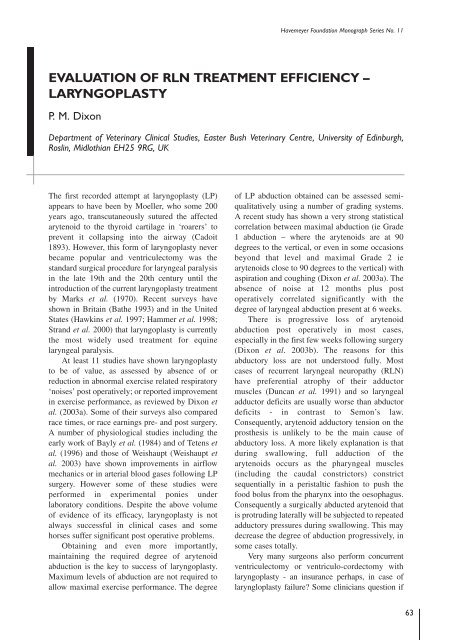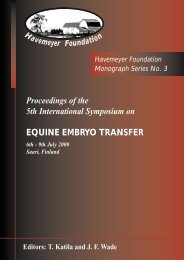Proceedings of a Workshop on - The Havemeyer Foundation
Proceedings of a Workshop on - The Havemeyer Foundation
Proceedings of a Workshop on - The Havemeyer Foundation
You also want an ePaper? Increase the reach of your titles
YUMPU automatically turns print PDFs into web optimized ePapers that Google loves.
<strong>Havemeyer</strong> Foundati<strong>on</strong> M<strong>on</strong>ograph Series No. 11<br />
EVALUATION OF RLN TREATMENT EFFICIENCY –<br />
LARYNGOPLASTY<br />
P. M. Dix<strong>on</strong><br />
Department <str<strong>on</strong>g>of</str<strong>on</strong>g> Veterinary Clinical Studies, Easter Bush Veterinary Centre, University <str<strong>on</strong>g>of</str<strong>on</strong>g> Edinburgh,<br />
Roslin, Midlothian EH25 9RG, UK<br />
<strong>The</strong> first recorded attempt at laryngoplasty (LP)<br />
appears to have been by Moeller, who some 200<br />
years ago, transcutaneously sutured the affected<br />
arytenoid to the thyroid cartilage in ‘roarers’ to<br />
prevent it collapsing into the airway (Cadoit<br />
1893). However, this form <str<strong>on</strong>g>of</str<strong>on</strong>g> laryngoplasty never<br />
became popular and ventriculectomy was the<br />
standard surgical procedure for laryngeal paralysis<br />
in the late 19th and the 20th century until the<br />
introducti<strong>on</strong> <str<strong>on</strong>g>of</str<strong>on</strong>g> the current laryngoplasty treatment<br />
by Marks et al. (1970). Recent surveys have<br />
shown in Britain (Bathe 1993) and in the United<br />
States (Hawkins et al. 1997; Hammer et al. 1998;<br />
Strand et al. 2000) that laryngoplasty is currently<br />
the most widely used treatment for equine<br />
laryngeal paralysis.<br />
At least 11 studies have shown laryngoplasty<br />
to be <str<strong>on</strong>g>of</str<strong>on</strong>g> value, as assessed by absence <str<strong>on</strong>g>of</str<strong>on</strong>g> or<br />
reducti<strong>on</strong> in abnormal exercise related respiratory<br />
‘noises’ post operatively; or reported improvement<br />
in exercise performance, as reviewed by Dix<strong>on</strong> et<br />
al. (2003a). Some <str<strong>on</strong>g>of</str<strong>on</strong>g> their surveys also compared<br />
race times, or race earnings pre- and post surgery.<br />
A number <str<strong>on</strong>g>of</str<strong>on</strong>g> physiological studies including the<br />
early work <str<strong>on</strong>g>of</str<strong>on</strong>g> Bayly et al. (1984) and <str<strong>on</strong>g>of</str<strong>on</strong>g> Tetens et<br />
al. (1996) and those <str<strong>on</strong>g>of</str<strong>on</strong>g> Weishaupt (Weishaupt et<br />
al. 2003) have shown improvements in airflow<br />
mechanics or in arterial blood gases following LP<br />
surgery. However some <str<strong>on</strong>g>of</str<strong>on</strong>g> these studies were<br />
performed in experimental p<strong>on</strong>ies under<br />
laboratory c<strong>on</strong>diti<strong>on</strong>s. Despite the above volume<br />
<str<strong>on</strong>g>of</str<strong>on</strong>g> evidence <str<strong>on</strong>g>of</str<strong>on</strong>g> its efficacy, laryngoplasty is not<br />
always successful in clinical cases and some<br />
horses suffer significant post operative problems.<br />
Obtaining and even more importantly,<br />
maintaining the required degree <str<strong>on</strong>g>of</str<strong>on</strong>g> arytenoid<br />
abducti<strong>on</strong> is the key to success <str<strong>on</strong>g>of</str<strong>on</strong>g> laryngoplasty.<br />
Maximum levels <str<strong>on</strong>g>of</str<strong>on</strong>g> abducti<strong>on</strong> are not required to<br />
allow maximal exercise performance. <strong>The</strong> degree<br />
<str<strong>on</strong>g>of</str<strong>on</strong>g> LP abducti<strong>on</strong> obtained can be assessed semiqualitatively<br />
using a number <str<strong>on</strong>g>of</str<strong>on</strong>g> grading systems.<br />
A recent study has shown a very str<strong>on</strong>g statistical<br />
correlati<strong>on</strong> between maximal abducti<strong>on</strong> (ie Grade<br />
1 abducti<strong>on</strong> – where the arytenoids are at 90<br />
degrees to the vertical, or even in some occasi<strong>on</strong>s<br />
bey<strong>on</strong>d that level and maximal Grade 2 ie<br />
arytenoids close to 90 degrees to the vertical) with<br />
aspirati<strong>on</strong> and coughing (Dix<strong>on</strong> et al. 2003a). <strong>The</strong><br />
absence <str<strong>on</strong>g>of</str<strong>on</strong>g> noise at 12 m<strong>on</strong>ths plus post<br />
operatively correlated significantly with the<br />
degree <str<strong>on</strong>g>of</str<strong>on</strong>g> laryngeal abducti<strong>on</strong> present at 6 weeks.<br />
<strong>The</strong>re is progressive loss <str<strong>on</strong>g>of</str<strong>on</strong>g> arytenoid<br />
abducti<strong>on</strong> post operatively in most cases,<br />
especially in the first few weeks following surgery<br />
(Dix<strong>on</strong> et al. 2003b). <strong>The</strong> reas<strong>on</strong>s for this<br />
abductory loss are not understood fully. Most<br />
cases <str<strong>on</strong>g>of</str<strong>on</strong>g> recurrent laryngeal neuropathy (RLN)<br />
have preferential atrophy <str<strong>on</strong>g>of</str<strong>on</strong>g> their adductor<br />
muscles (Duncan et al. 1991) and so laryngeal<br />
adductor deficits are usually worse than abductor<br />
deficits - in c<strong>on</strong>trast to Sem<strong>on</strong>’s law.<br />
C<strong>on</strong>sequently, arytenoid adductory tensi<strong>on</strong> <strong>on</strong> the<br />
prosthesis is unlikely to be the main cause <str<strong>on</strong>g>of</str<strong>on</strong>g><br />
abductory loss. A more likely explanati<strong>on</strong> is that<br />
during swallowing, full adducti<strong>on</strong> <str<strong>on</strong>g>of</str<strong>on</strong>g> the<br />
arytenoids occurs as the pharyngeal muscles<br />
(including the caudal c<strong>on</strong>strictors) c<strong>on</strong>strict<br />
sequentially in a peristaltic fashi<strong>on</strong> to push the<br />
food bolus from the pharynx into the oesophagus.<br />
C<strong>on</strong>sequently a surgically abducted arytenoid that<br />
is protruding laterally will be subjected to repeated<br />
adductory pressures during swallowing. This may<br />
decrease the degree <str<strong>on</strong>g>of</str<strong>on</strong>g> abducti<strong>on</strong> progressively, in<br />
some cases totally.<br />
Very many surge<strong>on</strong>s also perform c<strong>on</strong>current<br />
ventriculectomy or ventriculo-cordectomy with<br />
laryngoplasty - an insurance perhaps, in case <str<strong>on</strong>g>of</str<strong>on</strong>g><br />
laryngloplasty failure? Some clinicians questi<strong>on</strong> if<br />
63








